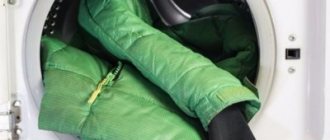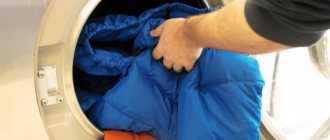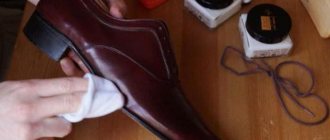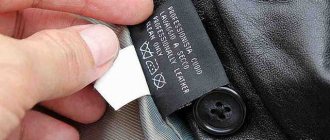Marina Korolkova Learned how to wash polyester
When I was 15 years old, I asked my mother for a long time to buy a new coat. She flatly refused. I had to wash my old coat in the machine in the hope that it would get ruined. I succeeded, because you can’t wash polyester like that! Soon my mother bought a new coat. Synthetic fabrics and polyester fibers require proper care. Today I know how to wash polyester in a washing machine and by hand, I’ll tell you.
Remember the rules for washing polyester
Follow the rules when caring for things made of polyester:
- Examine the label on the clothing. There are basic recommendations - hand/machine washing, maximum permissible water temperature, spin power, ironing temperature, etc. Sometimes only dry cleaning is allowed - contact a dry cleaner.
- water at a temperature not exceeding 50 º C. Otherwise, the item will be damaged and it will shrink a lot. And, for example, white polyester will turn yellow.
- Do not use bleaches or detergents containing chlorine. You can use washing powder, soap without bleaching effect, washing gel.
The ideal detergent for polyester - for every fabric color. Marked "color", "white" or "black".
Washing polyester with detergents containing chlorine means ruining the material. Photo: stozabot.com
- Do not dry polyester in the sun. This will ruin the fibers of the material.
Interpretation of icons on product labels. Photo: 4-red.ru
How to wash a coat - choice of products
An important feature when washing an autumn coat is that the product is classified as delicate.
It is demi-season coats that are most often created from natural fabrics that require careful washing. Choose liquid, gel or capsule detergents.
A winter coat may contain down or feather, padding polyester or holofiber as insulation. Based on this, the available funds are distributed:
- padding polyester, holofiber – liquid, gel products, capsules;
- down and feathers – specialized liquid products for down jackets, capsules.
Tide and Ariel capsules
- Price - 15 pieces of Tide - from 170 to 304 rubles and 13 pieces from Ariel - 190-365. The average cost of a capsule varies in the range of 12.8–23.8.
- Description - Available in capsule format. Suitable for machine wash only. The product cleanses, removes stains and enhances color.
- Purpose: You can wash delicate fabrics. Suitable for any type of material.
Pros/cons - despite the stated ability to whiten and remove stains, the capsules do not contain chlorine or aggressive substances, and are therefore suitable for washing coats. The disadvantages include the need for additional use of air conditioning.
Clean Home series washing gels
- Price - for 1 liter you will have to pay from 185 to 370 rubles.
- Description - Available in gel format, which is excellent for delicate washing, both by machine and by hand. There is both a universal gel and gels divided by color spectrum - for white, black, colored.
- Purpose - suitable for any type of product and material, including coats made of delicate fabric. Exception: winter coats filled with down and feathers.
Pros/cons - apart from the wide range in price (from low to moderate), can only be described on the positive side. Prevents the formation of pellets. Does not contain chlorine, phosphates, dyes, or aggressive chemicals. Washable even at low temperatures. Rinses out perfectly.
Gels BiMax, Tide, Persil, Ariel also deserve attention. Their characteristics, description and purpose are identical. They are great for washing coats of any type thanks to the gel base. Tide has the lowest price - you will have to pay 172 rubles per liter. BiMax has an inflated price tag (for 1 liter - 270 rubles), while having a number of disadvantages, unlike the products under consideration - it has an unpleasant odor.
You should make a choice based on color and type of material. For color and black, you cannot use the “For white” marking to avoid color washing out.
Focused products for cashmere, wool and delicate fabrics: Lint
- Price - for 750 ml - 107–120 rubles.
- Description - the gel formula allows it to dissolve in water without a trace.
- Purpose: Suitable for woolen and delicate fabrics.
Pros/cons - rinses well both after machine and hand washing. Prevents the formation of pellets. Does not contain bleach or phosphates, making it suitable for colored and white materials. The downside is that it has a fragrance, but it is unobtrusive.
Heitmann – gel for washing winter coats with down and feathers
- Price - from 399 to 479 for 250 ml.
- Description - a liquid gel product specially designed for winter coats made of down and feathers.
- Purpose - suitable for any type of washing.
Pros/Cons - Maintains color vibrancy. The filler does not roll, does not fall off, and retains its thermal insulation and air tightness properties. A significant disadvantage is that it does not always fully cope with contamination.
Beckmann stain removers
The unsuitability of products containing chlorine and active oxygen for cleaning coats has already been indicated. Next up are stain removers. The Dr. line has proven itself well. Beckmann.
- Price - from 113 to 197 per 50 ml - depending on the type of stain.
- Description - for each type of stain there is a different stain remover option (fats and sauces, fruits and drinks, blood and protein stains, etc.)
- Purpose - suitable for washing woolen and delicate fabrics by machine or hand washing.
Pros/cons - the product will help you deal with stains even on items that are not recommended for washing (cleaning only). They have a directional effect. Does not contain fragrances or phosphates.
Washing powders, bleaches, stain removers with chlorine or active oxygen should not be used. Therefore, when choosing from the line, remember that products containing active oxygen are not recommended for coats made of natural fabrics.
Wash by hand - safe
Yes, washing a parka or other item is troublesome and takes a lot of time. But the stains will be washed off, and the clothes will not lose their decent appearance. This is especially true for polyester coats (from experience), jackets and down jackets.
Instructions for hand washing polyester fabrics:
- Fill a basin with warm water - 30–40 ºC, no more.
- Add and thoroughly dissolve the detergent in the water.
- If the item is very dirty, soak it in this water for half an hour to an hour.
- If there are old, stubborn stains, rub them with laundry soap.
- After the time has passed, add hot water to the basin after removing the item.
- Press the item in a circular motion in the water, without rubbing the fabric too much with your hands.
- Rinse in cool water.
- Lightly wring out the washed item, do not twist or pull it.
- Hang it on a hanger right above the bathtub and let the water run away on its own.
- Then move it where it is convenient for you, but away from heating appliances. Do not remove from hangers to avoid deformation of the fabric.
To speed up drying, take a terry towel and wrap the washed polyester item in it. The towel will absorb most of the moisture.
A terry towel will speed up drying; wrap the washed item in it for 7-10 minutes. Photo: home-gid.com
Routine care
Daily care is especially important in the off-season, when you need to clean your coat from street dust, dirt and precipitation. Cleaning includes several simple steps:
- when you come home, shake off the dust from your coat;
- hang it on hangers so that the fabric does not stretch and the item retains its shape;
- walk over the surface with a clothes brush, and if the coat is black, then with a roller to remove stuck threads or hairs.
If the product is wet from rain or snow, and dirt gets on the hem, there is no need to clean it up in a wet state. First you need to let it dry on a hanger, and then clean it with a brush.
Machine wash
You can wash items made of polyester in a machine using the “manual”, “delicate” or “sport” mode at a water temperature of 30–40 °C.
Photo: hoznauka.ru You can wash polyester in a washing machine if the tag indicates that machine wash is acceptable. But you need to follow a few rules:
- Do not put polyester clothes in the same drum as wool and cotton items - otherwise pilling is inevitable.
- Set the washing program to 30–40 °C. Too cold water will not cope with greasy stains, and hot water causes polyester to deform, wrinkle, and lose color.
- Wash polyester items in a special protective mesh cover. First of all, this applies to expensive blouses and openwork underwear.
- If the item is heavily soiled , first run it through the “soak” or “pre-wash” mode. This will double the chances of it being completely cleansed.
- Spin - no more than 400 rpm. Then hang the item on hangers and let it dry naturally.
Mesh bag for delicate washing TOP HOUSE 50x70 for 3 kg. Price - about 500 rubles. Photo: static.eldorado.ru A little life hack - adding conditioner to the wash will save polyester from the unpleasant electrification effect inherent in synthetics.
Machine wash a coat or jacket
Outerwear can easily survive both hand and machine washing, if you do not neglect the conditions. But I recommend taking coats with complex decorative folds and expensive down jackets to the dry cleaner.
Tennis balls are a good replacement for rubber balls. Perform the same functions. Photo: storage.commerage.ru
Instructions on how to machine wash a polyester jacket:
- Remove all items from your coat pockets and fasten all zippers/buttons/studs.
- Turn your outerwear inside out.
- Load into the washing machine drum.
- Set the mode to “hand wash” or “delicate”. Water temperature - no higher than 40 ºC, spin - at the lowest speed, rinse - twice.
- It is better to wash winter outerwear with liquid powder or washing gel. Liquid detergent will be well washed out of the insulation fibers, but loose powder may remain inside and leave whitish streaks when dried.
- Add conditioner before the second rinse. It will prevent the filler from crumpling.
- Take out the product, lay it out on a flat horizontal surface, and straighten the filler with your hands. A polyester jacket is dried with the hem up or in a horizontal position - this quickly returns it to its original volume and shape. Periodically squeeze out the moisture and shake the coat.
To ensure that the jacket regains its previous shape and volume, dry it in a horizontal position, shaking it occasionally. Photo: nikwax.files.wordpress.com
General rules
The first step is to assess the need and possibility of cleaning or washing, and determine the means necessary for these actions. A reliable source of information needed in this case is the product tag. The symbols placed on it by the manufacturer regulate the permissible parameters and modes of operation with the product.
Regardless of the chosen type of processing and devices for this, consumers are advised to adhere to the following general rules when processing coats:
- if it is worn rarely, then cleaning should be done after each wear;
- before and after long-term storage of the coat, the product is thoroughly processed over the entire surface;
- the product chosen for treating the coat must be tested on an inconspicuous piece of fabric, wait for the full cycle of action of the cleaning powder or liquid, and only then evaluate its effect on the material of the product;
- look through the internal and external pockets, emptying them of any objects and small items;
- shake out the product to remove large dirt and dust accumulated on the pile;
- examine the object in bright light to identify visible dirt and stains;
- remove the top layer of dust and dirt from the surface of the item with a dry brush;
- In accordance with the type of material, select the method of further processing and cleaning agents for this.
Wash a blanket or pillow
A blanket or other bulky items made of polyester must be placed freely in the drum, otherwise they will wrinkle and not be washed.
Photo: images.kz.prom.st Polyester filling means holofiber, which is used to stuff blankets and pillows. Manufacturers recommend dry cleaning such items, but I successfully machine wash:
- delicate mode;
- liquid powder or gel;
- double rinse;
- minimum spin speed.
But there are still some simple requirements:
- If the drum capacity is more than 5 kg , blankets and pillows can be washed; if the load is smaller, they cannot be washed.
Before washing a pillow, do a mini-test: place a heavy object on it, then remove it. If the pillow returns to its previous shape within a few seconds, you can safely put it in the washing machine. If not, then most likely the filler has already done its job.
- Blankets and pillows are dried in a horizontal position ! In a well-ventilated area or in direct sun, otherwise a musty smell will appear. With polyester it is easier in this regard, it dries quickly, the main thing is not to forget to turn over and beat the product from time to time so that the holofiber does not crumple.
- If the filler has lost its shape. Using a metal brush for cats, fluff up the holofiber and spread the blanket or pillow on the side. After this beating, return the filler back, evenly distributing it over the entire area, and sew up the torn area. If this does not help, then you can purchase new polyester filling at a haberdashery or sewing store.
You can restore the filler with a wire brush. Photo: mschistota.ru
Features and types of wool blankets
Natural wool bedding is valued by consumers for its environmental friendliness, durability, and ability to retain heat better than synthetic ones.
Depending on the manufacturing method and technology, there are several types of such products:
- seamless;
- quilted;
- printed (single-sided or double-sided).
Is it possible to wash a wool blanket in a machine?
If improperly cleaned, the item will lose its original properties. If you do not want to waste time washing by hand, then you can do this using a washing machine, but according to certain rules.
The drum should have a volume of 5-6 kg. Not all types of blankets can be cleaned, but only those quilted from sheep wool, as well as from camel and goat wool. And only if they have a special label indicating that they can be washed in a machine.
Features of dry cleaning
If you are afraid of spoiling an expensive item at home, then it is better to entrust the cleaning process to professionals.
Woolen items can be dry-cleaned, which would be even better. There's your blanket:
- cleaned of contaminants;
- remove difficult stains, such as coffee stains;
- disinfect;
- steamed;
- will be restored.
After removing the stains from the outside, the filler is cleaned using special synthetic products. They are hypoallergenic and absolutely safe for humans and animals. These substances will completely remove accumulated dirt and dust. Then drying and ironing is carried out using professional equipment. During this process, all remaining microorganisms die under the influence of high temperatures.
After such work, even the oldest “grandmother’s” blanket will look new; a similar result cannot be achieved at home.
The price of dry cleaning may vary depending on several factors: the type of filling, the size of the blanket and the number of services chosen. In general, the amount will be approximately 500-3000 rubles. The cheapest treatment will be one that includes only dry cleaning, washing, drying, and ironing. If you want the service to be completed faster, you can pay extra for speed.
Remove stains: 8 ways
Although polyester is quite resistant to stains, stubborn stains appear on it too. To get rid of them, it is better to use mild means.
Before using any method, be sure to test it on an inconspicuous area. Soak a cotton swab in the product and press it onto the fabric for a couple of minutes. If the cotton wool is not stained and the polyester does not lighten, then the stain remover has passed the test.
| Character of stains on polyester | Removal agent |
Salt
| |
10% borax solution
| |
Hair fixation spray
Lemon juice and salt paste
| |
| Hydrogen peroxide Dried blood can be removed with a 3% hydrogen peroxide solution. Before use, be sure to test in an inconspicuous area how the fabric behaves! Cold water Fresh blood can be easily washed off with cold water. Sometimes it is enough to rub the area with an ice cube | |
Vinegar and cold water
|
Wet processing of cashmere, drape, wool
Only wet treatment will help in cleaning a cashmere coat from dust and dirt. First, the top layer of accumulated dust is removed from the coat with a dry brush. Subsequently, soak the entire surface of the product with a soap solution on a soft sponge.
Drape is recognized by experts as a capricious material. Processing a drape coat with careless actions or incorrectly selected products can lead to shrinkage of the material. Improper drying of the product leads to deformation of the fabric.
In case of extensive stains that have already been absorbed into the structure of the fabric, it is better to entrust the cleaning of the coat to the actions of dry cleaning professionals.
If the problem areas are small or have just been received and have not had time to dry, then it is permissible to solve the problem of cleaning the coat at home, following this procedure:
- Before processing, the product is placed vertically.
- Remove the top layer of settled dust in two stages: first, shake the coat vigorously, then brush over the entire surface.
- Place the product on a horizontal surface and sprinkle visible areas of contamination with a special store-bought powder for wool items. Remains of the cleaning agent are removed with a dry brush. Grease stains are cleaned with a mild soap solution and a soft sponge. Contamination from coffee and tea on the drape product is cleaned with a weak saline solution and a soft sponge.
The delicate and sensitive material of a woolen coat can be cleaned at home, subject to certain rules:
- Debris, large fluff, and various adhered elements are removed with special devices: a brush or roller.
- It is recommended to treat severe dirt or shiny, shiny areas with a solution of four parts table salt and one part ammonia. The mixture is applied to problem areas, after a third of an hour it is removed along with the dirt using a brush.
- Shiny and greasy areas are cleaned with a solution of ethyl alcohol and table vinegar.
- Green tea or a warm solution of laundry soap successfully remove stains on dark-colored fabrics. For this purpose, dip a cotton pad in one of these products and wipe the contaminated areas with it.
Remember
As you have seen, you can wash polyester in a washing machine and by hand without any loss, even jackets and blankets! The main thing is to remember the main points of caring for polyester:
- Choose a washing mode - manual or delicate. Minimum spin speed, additional rinsing.
- Adjust the water temperature - 30–50 ºС . At higher temperatures, polyester will deteriorate.
- Use mild detergents. No aggressive means. Polyester does not tolerate bleaches or stain removers.
- Wash polyester separately. Otherwise, pellets will appear.
- Dry polyester naturally. Away from heating devices and direct sunlight - on hangers. Avoid deformation.
- Dry bulky items (down jackets, blankets, pillows) in a horizontal position. So that the filler does not get lost.
- Set the ironing temperature to 120–130 ºC . The iron mode is “silk”.
- Read the label on the clothing. Before any manipulations with polyester, decipher the symbols on the label.
How to dry properly
If the item dries slowly (for example, in damp weather), an unpleasant odor will appear and the item will have to be washed again.
The filling may fall out if the jacket is not dried correctly.
You need to wait for suitable weather conditions, wash the jacket and perform a number of actions:
- Place the clothes dryer on the balcony so that it is not exposed to direct sunlight.
- Lay out a couple of terry towels and put your jacket on them.
- After 1.5–2 hours, shake, smooth out wrinkles, then turn the item over.
Repeat the last step until completely dry.











